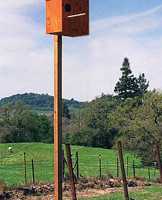Rodent Control Tips For Vineyards

Pesky voles and other rodents can be a huge inconvenience in vineyards and orchards, and increasingly, growers are turning to birds of prey, such as barn owls, for organic control of these pests.
So, how do you get these benevolent birds to nest on your property? Building an owl box is a good start. According to Tom Hoffman, a Lodi, CA-based winegrape grower who has been using owls for years to control rodents in his vineyard, owls are a great source of rodent control because they work for free, while you’re asleep. “It is estimated that a family of five young and two adults will eat several thousand rodents during the nesting season,” he adds. “The adults may eat only once every two nights, but the growing young eat two, three, or four a night. They are in the nest for 14 weeks, so this adds up to a lot of mice and gophers.”
Providing suitable nesting sites is key to attracting owls, and because natural nesting sites like trees with holes have begun to disappear, growers have an excellent opportunity to create homes for these birds. “They will move right into a man-made nesting box,” Hoffman says.
Attributes And Placement
Hoffman says owls aren’t too picky about nests. The size of the opening is the most important aspect, and usually a 5- to 6-inch cavity does the trick. Other features owls will like but won’t require are perches and sunshields. He adds that you can place owl boxes wherever you like. “I look for sites that have limited traffic and where their castings (pellets) and fecal matter won’t bother equipment,” he says. “I also like to place boxes in the vicinity of a tree so the young will have a place to fly to on their first outing.”
One place you should not put an owl box is near old oaks or other stands of established trees, which are the habitat of the Great Horned Owl — a predator of barn owls.
While Hoffman says there’s no real formula for determining how many owl boxes you should have per acre, he subscribes to the philosophy that more is better. “If you have 50 acres that are heavily infested with rodents, I’d put up four, five, or six boxes,” he says. “When the owls have found half of them, I’d stick up some more. Having 50% to 70% occupancy should be considered a threshold for needing additional nesting sites.”
In addition, the boxes should be placed at least 12 feet off the ground so they’re safe from other critters but low enough for you to access easily.
Owl boxes need to be cleaned out annually, too, so Hoffman recommends your boxes include a mechanism for easy cleaning, such as a bottom drop or a side door.
Precautions
You shouldn’t employ owl boxes until you’ve first considered some of the potential implications. For example, Hoffman says, you can’t forget that owls are wild animals. They will defend themselves and their young at all costs, so you must respect their space.
They can be unpredictable, too, so try to keep them away from places like schools. “They can also be very noisy, so keep the nest boxes away from your bedroom window,” he adds.
And if you’re also using bait to eliminate rodents, be careful what kind you’re using. “Using anticoagulant bait on rodents can also affect the owls, as it may build up in their system,” Hoffman says. “So if you want to bait while owls are present, use something that kills at a single feeding. They will not take prey that is dead or not acting naturally.”
Owl Box Inspection And Cleaning
Inspecting and cleaning owl boxes are important steps not to be overlooked. Here are some tips, courtesy of Hoffman:
• June inspection: Cleaning should be done after the last chick leaves the nest in late spring. Remove the remains of any dead animals and the old wood shavings. The box interior can be disinfected with a solution of 2% household bleach sprayed into the box.
• Fall inspection: Inspection in November or early December, before the adult owls return for the breeding season, is also necessary to ensure paper wasps or honeybees have not inhabited the box. If wasps or bees are present, they should be removed or killed with a pyrethrin-based insecticide. The nest should be removed and destroyed.
• Optional inspections: Inspection in January may occur if a grower wants to know if owls are inhabiting the box. Signs of inhabitation are white fecal material and pellets lying on the ground around the base of the box and an accumulation of dirt around the door.










